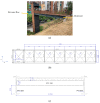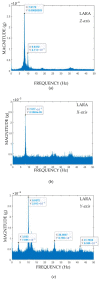Low-Cost Wireless Structural Health Monitoring of Bridges
- PMID: 35957280
- PMCID: PMC9371212
- DOI: 10.3390/s22155725
Low-Cost Wireless Structural Health Monitoring of Bridges
Abstract
Nowadays, low-cost accelerometers are getting more attention from civil engineers to make Structural Health Monitoring (SHM) applications affordable and applicable to a broader range of structures. The present accelerometers based on Arduino or Raspberry Pi technologies in the literature share some of the following drawbacks: (1) high Noise Density (ND), (2) low sampling frequency, (3) not having the Internet's timestamp with microsecond resolution, (4) not being used in experimental eigenfrequency analysis of a flexible and a less-flexible bridge, and (5) synchronization issues. To solve these problems, a new low-cost triaxial accelerometer based on Arduino technology is presented in this work (Low-cost Adaptable Reliable Accelerometer-LARA). Laboratory test results show that LARA has a ND of 51 µg/√Hz, and a frequency sampling speed of 333 Hz. In addition, LARA has been applied to the eigenfrequency analysis of a short-span footbridge and its results are compared with those of a high-precision commercial sensor.
Keywords: Arduino Due; Raspberry Pi; accelerometers; eigenfrequency analysis; low-cost sensors; short-span footbridge.
Conflict of interest statement
The authors declare no conflict of interest.
Figures












Similar articles
-
Operational and Analytical Modal Analysis of a Bridge Using Low-Cost Wireless Arduino-Based Accelerometers.Sensors (Basel). 2022 Dec 14;22(24):9808. doi: 10.3390/s22249808. Sensors (Basel). 2022. PMID: 36560186 Free PMC article.
-
A Novel Wireless Low-Cost Inclinometer Made from Combining the Measurements of Multiple MEMS Gyroscopes and Accelerometers.Sensors (Basel). 2022 Jul 27;22(15):5605. doi: 10.3390/s22155605. Sensors (Basel). 2022. PMID: 35957164 Free PMC article.
-
Development of a High-Sensitivity Wireless Accelerometer for Structural Health Monitoring.Sensors (Basel). 2018 Jan 17;18(1):262. doi: 10.3390/s18010262. Sensors (Basel). 2018. PMID: 29342102 Free PMC article.
-
Low-Cost Sensors Technologies for Monitoring Sustainability and Safety Issues in Mining Activities: Advances, Gaps, and Future Directions in the Digitalization for Smart Mining.Sensors (Basel). 2023 Aug 1;23(15):6846. doi: 10.3390/s23156846. Sensors (Basel). 2023. PMID: 37571628 Free PMC article. Review.
-
Micromachined Accelerometers with Sub-µg/√Hz Noise Floor: A Review.Sensors (Basel). 2020 Jul 21;20(14):4054. doi: 10.3390/s20144054. Sensors (Basel). 2020. PMID: 32708191 Free PMC article. Review.
Cited by
-
Prediction of the Physical Properties of a Structural Member by the Impact Hammer Test.Sensors (Basel). 2022 Sep 7;22(18):6762. doi: 10.3390/s22186762. Sensors (Basel). 2022. PMID: 36146107 Free PMC article.
-
Application of MEMS Accelerometers in Dynamic Vibration Monitoring of a Vehicle.Micromachines (Basel). 2023 Apr 24;14(5):923. doi: 10.3390/mi14050923. Micromachines (Basel). 2023. PMID: 37241547 Free PMC article.
-
Towards the Structural Health Monitoring of Bridges Using Wireless Sensor Networks: A Systematic Study.Sensors (Basel). 2023 Oct 14;23(20):8468. doi: 10.3390/s23208468. Sensors (Basel). 2023. PMID: 37896561 Free PMC article. Review.
-
Low-Cost Efficient Wireless Intelligent Sensor (LEWIS) for Research and Education.Sensors (Basel). 2024 Aug 16;24(16):5308. doi: 10.3390/s24165308. Sensors (Basel). 2024. PMID: 39205002 Free PMC article.
-
Dynamic Multi-Axis Calibration of MEMS Accelerometers for Sensitivity and Linearity Assessment.Sensors (Basel). 2025 Mar 27;25(7):2120. doi: 10.3390/s25072120. Sensors (Basel). 2025. PMID: 40218631 Free PMC article.
References
-
- Proske D. Proceedings of the Institution of Civil Engineers—Bridge Engineering. Volume 173. Thomas Telford Ltd; London, UK: 2020. Fatalities due to bridge collapse; pp. 260–267. - DOI
-
- Structurally Deficient Bridges. [(accessed on 9 October 2020)]. Available online: https://www.infrastructurereportcard.org/cat-item/bridges/
Grants and funding
- BIA2017-86811-C2-1-R/the Spanish Ministry of Economy and Competitiveness
- BIA2017-86811-C2-2-R/the Spanish Ministry of Economy and Competitiveness
- 2017 SGR 1482/Secretaria d' Universitats i Recerca de la Generalitat de Catalunya
- PRE2018-083238/Spanish Agencia Estatal de Investigación del Ministerio de Ciencia Innovación y Universidades
LinkOut - more resources
Full Text Sources
Research Materials
Miscellaneous

